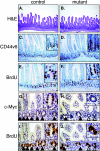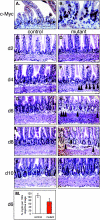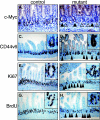c-Myc is required for the formation of intestinal crypts but dispensable for homeostasis of the adult intestinal epithelium
- PMID: 16107730
- PMCID: PMC1190312
- DOI: 10.1128/MCB.25.17.7868-7878.2005
c-Myc is required for the formation of intestinal crypts but dispensable for homeostasis of the adult intestinal epithelium
Abstract
In self-renewing tissues such as the skin epidermis and the bone marrow, Myc proteins control differentiation of stem cells and proliferation of progenitor cell types. In the epithelium of the small intestine, we show that c-Myc and N-Myc are expressed in a differential manner. Whereas c-Myc is expressed in the proliferating transient-amplifying compartment of the crypts, N-Myc is restricted to the differentiated villus epithelium and a single cell located near the crypt base. c-Myc has been implicated as a critical target of the canonical Wnt pathway, which is essential for formation and maintenance of the intestinal mucosa. To genetically assess the role of c-Myc during development and homeostasis of the mammalian intestine we induced deletion of the c-myc(flox) allele in the villi and intestinal stem cell-bearing crypts of juvenile and adult mice, via tamoxifen-induced activation of the CreER(T2) recombinase, driven by the villin promoter. Absence of c-Myc activity in the juvenile mucosa at the onset of crypt morphogenesis leads to a failure to form normal numbers of crypts in the small intestine. However, all mice recover from this insult to form and maintain a normal epithelium in the absence of c-Myc activity and without apparent compensation by N-Myc or L-Myc. This study provides genetic and molecular evidence that proliferation and expansion of progenitors necessary to maintain the adult intestinal epithelium can unexpectedly occur in a Myc-independent manner.
Figures






Similar articles
-
Phases of canonical Wnt signaling during the development of mouse intestinal epithelium.Gastroenterology. 2007 Aug;133(2):529-38. doi: 10.1053/j.gastro.2007.04.072. Epub 2007 May 3. Gastroenterology. 2007. PMID: 17681174
-
Epithelial hedgehog signals pattern the intestinal crypt-villus axis.Development. 2005 Jan;132(2):279-89. doi: 10.1242/dev.01576. Epub 2004 Dec 8. Development. 2005. PMID: 15590741
-
Wnt/beta-catenin is essential for intestinal homeostasis and maintenance of intestinal stem cells.Mol Cell Biol. 2007 Nov;27(21):7551-9. doi: 10.1128/MCB.01034-07. Epub 2007 Sep 4. Mol Cell Biol. 2007. PMID: 17785439 Free PMC article.
-
Intestine-specific gene transcription.Annu Rev Physiol. 1996;58:275-97. doi: 10.1146/annurev.ph.58.030196.001423. Annu Rev Physiol. 1996. PMID: 8815796 Review.
-
The proto-oncogene c-myc in hematopoietic development and leukemogenesis.Oncogene. 2002 May 13;21(21):3414-21. doi: 10.1038/sj.onc.1205400. Oncogene. 2002. PMID: 12032779 Review.
Cited by
-
Single-cell map of dynamic cellular microenvironment of radiation-induced intestinal injury.Commun Biol. 2023 Dec 9;6(1):1248. doi: 10.1038/s42003-023-05645-w. Commun Biol. 2023. PMID: 38071238 Free PMC article.
-
Drosophila Myc integrates multiple signaling pathways to regulate intestinal stem cell proliferation during midgut regeneration.Cell Res. 2013 Sep;23(9):1133-46. doi: 10.1038/cr.2013.101. Epub 2013 Jul 30. Cell Res. 2013. PMID: 23896988 Free PMC article.
-
c-Myc induction of programmed cell death may contribute to carcinogenesis: a perspective inspired by several concepts of chemical carcinogenesis.Cancer Biol Ther. 2011 Apr 1;11(7):615-26. doi: 10.4161/cbt.11.7.14688. Epub 2011 Apr 1. Cancer Biol Ther. 2011. PMID: 21278493 Free PMC article. Review.
-
Skin epidermis lacking the c-Myc gene is resistant to Ras-driven tumorigenesis but can reacquire sensitivity upon additional loss of the p21Cip1 gene.Genes Dev. 2006 Aug 1;20(15):2024-9. doi: 10.1101/gad.381206. Genes Dev. 2006. PMID: 16882980 Free PMC article.
-
Nursing some sense out of Myc.J Biol. 2009 Sep 28;8(8):77. doi: 10.1186/jbiol181. J Biol. 2009. PMID: 19804609 Free PMC article.
References
-
- Alarcon, R. M., B. A. Rupnow, T. G. Graeber, S. J. Knox, and A. J. Giaccia. 1996. Modulation of c-Myc activity and apoptosis in vivo. Cancer Res. 56:4315-4319. - PubMed
-
- Amati, B., K. Alevizopoulos, and J. Vlach. 1998. Myc and the cell cycle. Front Biosci. 3:D250-68. - PubMed
-
- Askew, D. S., R. A. Ashmun, B. C. Simmons, and J. L. Cleveland. 1991. Constitutive c-myc expression in an IL-3-dependent myeloid cell line suppresses cell cycle arrest and accelerates apoptosis. Oncogene 6:1915-1922. - PubMed
-
- Augenlicht, L. H., S. Wadler, G. Corner, C. Richards, L. Ryan, A. S. Multani, S. Pathak, A. Benson, D. Haller, and B. G. Heerdt. 1997. Low-level c-myc amplification in human colonic carcinoma cell lines and tumors: a frequent, p53-independent mutation associated with improved outcome in a randomized multi-institutional trial. Cancer Res. 57:1769-1775. - PubMed
Publication types
MeSH terms
Substances
LinkOut - more resources
Full Text Sources
Medical
Molecular Biology Databases
